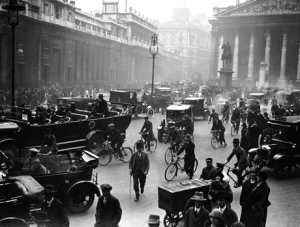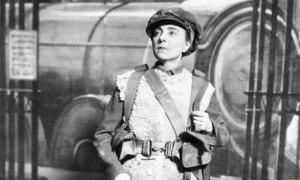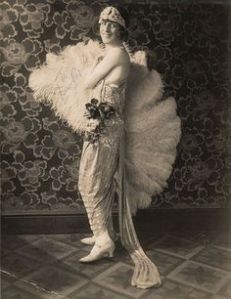My desire to uncover the multifarious stories our history is waiting to impart is unending. At Oxford I discovered my fascination with the intertwined stories of gender, sexuality, transgression and identity.
This fascination falls tightly in line with my absolute belief in sexual and social equality, and the necessity I found to prove that people, at their true core, are accepting of others in all their forms. What was born was a study of transgression in one of the most topsy-turvy periods in British history; what it uncovered was an underground movement that operated in plain sight, one that was largely reactive to the unsettling confusion of a post-war world. It would form the basis of the way in which we view gender, sexuality and identity today. My only hope is that it resonates with you, the reader.
~~~
Have historians exaggerated the extent to which cross-dressing was seen as a threat in the 1920s?
“Masculine women, feminine men…it’s hard to tell ‘em apart today”[1] sang the Savoy Havana Band in 1927. This decade saw the ‘painted boy’ and the ‘man-woman’ in the press, on the screen and the street. Cross-dressing captured the public imagination. Why then, when enacted by the public and in the arts of the time, was it met with such panic from the establishment and such harsh discipline from the law? Cross-dressing in this period was commonplace in popular culture: alluded to in songs, enacted on the stage and parodied for entertainment. Yet on the streets it was seen in a rather different light, policed and punished. Not being able to “tell ‘em apart” was part of the problem with cross-dressing that went far deeper than the consideration of it as a harmless pastime. It subverted the established gendered and sexual categories of male and female, masculine and feminine, heterosexual and homosexual; its capacity to undermine social hierarchy, gender order and the rigid contemporary boundaries of acceptable sexual conduct was its crime.

Cross-dressing in the 1920s did not have one particular face. It was male-to-female and vice versa; the wearing of make-up, accessories or full drag either for expression of gender, desire, in fashion or to pass. In a court of law it had uncertain status, in popular opinion it had no one implication. Different forms of cross-dressing must be considered here as they had varying meanings and connotations in the twenties. These differences will be explored within distinct sections concerning male and female cross-dressing. The two practices were seen as profoundly different by many contemporaries, as were male and female homosexuality[2]; as such they must be considered separately here.

There exists debate between historians as to the nature and extent of the threat of cross-dressing. Matt Houlbrook and Marjorie Garber have discussed cross-dressing in terms of its perceived threat to society at the time; Garber propounds the “extraordinary power”[3] of cross-dressing to unsettle identity and category, while Houlbrook emphasises its “transgression” of gender roles and acceptable sexuality[4]. Laura Doan and others such as Alison Oram underplay this by describing reactions to the practice as “unalarmed” in this period[5], emphasising the prevalence of cross-dressing in the public eye. Here, though, is the divergence. This essay will argue that those historians proposing cross-dressing as a threat have not exaggerated its perceived danger to the public, and those who have denied its threat have viewed cross-dressing too closely in relation to its enaction on the stage and on the page, as what was constructed within contained boundaries and what existed in the public arena were two very different things.

Male and female cross-dressing were both unsettling practices, albeit partly for divergent reasons. The threat of cross-dressing was not necessarily in the act itself, but in what it stood for. It is paramount here to historicise views of gender and sexuality and their manifestations. Cross-dressing in this decade was almost unanimously viewed by the public as inherently related to sexuality, most especially in men, and in the later twenties in women. The work of sexologists including Havelock Ellis brought psychological and medical discourses of homosexuality and gender to the public through the dissemination of ideas into popular works such as Taylor Croft’s The Cloven Hoof; in these theories the gendered body was the signifier of sexual difference. Thus the man or woman on the street and on the page was a threat not in what they wore per se but thus who they were and what that meant they did. Sources from the 1920s reveal much about the threat of cross-dressing in their language, tone and, indeed, in their very existence. Masculine Women, Feminine Men! may have been a light-hearted comment on the state of the nation, but its existence as a statement at all affirms the threat of cross-dressing as gender inversion, sexual unnaturalness and social upheaval. In short, cross-dressing was a threat for its part in the wider crisis of social and sexual boundaries in the 1920s.
Georgia Mizen
nowasIwrite
[1] Words by Edgar Leslie, music by James V. Monaco, ‘Masculine Women, Feminine Men!’ (song), (Melbourne: L.F. Collin, 1925)
[2] Taylor Croft, ‘Homosexuality Among Women’, The Cloven Hoof: A Study of Contemporary London Vices, (London 1932) p. 78
[3] Marjorie Garber, Vested Interests: Cross-Dressing and Cultural Anxiety, (New York 1992), p. 16
[4] Matt Houlbrook, Queer London: Perils and Pleasures in the Sexual Metropolis, 1918-1957, (Chicago 2005) pp. 22-23
[5] Laura Doan, ‘Topsy-Turvydom: Gender Inversion, Sapphism and the Great War’, GLQ A Journal of Lesbian and Gay Studies, Vol. 12(4) (2006), p. 518

I am currently reading, and enjoying “My Husband Betty”, and so is my wife. We had not heard of people like Haveloc Ellis or Kraffts-Ebing or Hirschfield before. After reading this article, I am just a little curious about what kind of data sets they used, in particular, not so much of the “who” they studied, but “where” they were studied, and just as important, the “when”.
I pretty sure our attitudes towards cross dressing in the Western hemisphere are not the only attitudes that come into play. I wonder if the advances in transportation and communications that resulted from the technology boom of the WWI era might have brought some of the ideals of the Eastern hemisphere out into a broader section of the Western hemisphere’s population.
Additionally, I also wonder if these observations that were made in the 1920’s about the culture have anything to do with the state of the Human condition post World War One. The staggering amount of resources pumped into that conflict by the opponents in they’re bid to win that war unleashed all kinds of new knowledge, both beneficial, and some not so much.
Could it be that people just decided that after experiencing the carnage WWI, they just said “You know what? That was pretty close, let’s party” and they lit the fuse for the Roaring 20’s?
I believe there was another conflict that had the same effect on the worlds population, and that was the WWII/ColdWar/Korea/Vietanam miasma. That was a doozy that gave rise to the 60’s. They sixties I remember growing up in. I can remember in 1965, when I was 5 years old, my parents went to a lot of parties. They seemed to be partying all the time.
I wonder if it was the specter of the next “one” going nuclear? I wonder if they just said the same thing people of the post WWI generation said “Hey, that was pretty close”, but they were faced with the prospect the next time it would all be over in the blink of an eye.
I know one thing about my parents, they were pretty tolerant. And it wasn’t just my parents, it was pretty much all the adults I met. They seemed to want to pack as much living into each moment as they could.
If this is the case, I don’t think it is outside the realm of possibility, that there were lot of men saying “you know, I just want to look pretty, I just want to experience that before someone pushes the button”.
LikeLike
My Husband Betty sounds great, I’ve not heard of that book before so that’s for bringing it to my attention! I spent some time focusing on Ellis’ works at university, and as far as I understand it he worked on case studies from a medical and psychological perspectives, though certainly his views were influenced by what we would probably call investigative journalism from several angles. Aside from Ellis’ works themselves (especially Sexual Inversion), some great texts to take a look at include Matt Houlbrook’s Queer London and articles in Gender & History volume 12.
I agree with where you’re coming from, though that’s slightly outside the scope of what I’ve written here. I’m sure the idea that they’d got off lightly after the way played a part in the reason why people desired freedom, evidenced in the greater cry for the vote for women. I think the way in which cross-dressing was related to sexuality in this period was vastly misunderstood, and that’s partly why I wanted to shed light on it. I completely concur with you that the war had a tremendous impact on the human condition, and thus what people then said or did. I’m convinced, though, that there were far more significant elements at play, especially when considering the very real possibility of fines and jail time, that resulted in men dressing like women and vice versa. In any case, it’s an incredibly intriguing period in British, and American and Australian, histories that I encourage everyone to look into.
LikeLike